Baltic States Part II: Latvia
The interest of U.S. business in the Baltic States is growing rapidly, most recently shown by the U.S. Investment and Trade Mission to the Baltic States at the end of May 2006. Looking at each Baltic State separately, we can see intensive economic development, as well as a large growth in trade and investments. This article, second of a three-part series on the region, draws your attention to Latvia and its connections to the United States and Indiana.
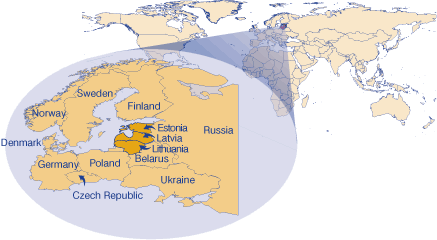
The Nation
Latvia has 2.3 million people, making it the second largest Baltic State. The majority of the population is Latvian (57 percent), with Russians as the next largest ethnic group (29.6 percent).
This country, which is slightly larger then West Virginia, is located at the crossroads of Northern and Eastern Europe, on the east coast of the Baltic Sea. Latvia borders Estonia on the north, Russia and Belarus to the east, and Lithuania to the south.
The Baltic States declared independence in 1991 after the collapse of the Soviet Union. After a difficult transition period, they joined NATO and the European Union in 2004. Latvia was also the first Baltic country to be accepted to the World Trade Organization (WTO) in 1998.
Economy
Latvia has already completed privatization of small and medium enterprises and some larger ones. Currently, it is experiencing steady growth in foreign direct investment (FDI), especially from the Scandinavian states (see Figure 1). Latvia was ranked sixth among new EU states for FDI stock per capita. Since 2000, Latvian GDP has increased annually by 7.7 percent. Such indicators of development are among the highest in the European Union.
Figure 1: Foreign Direct Investment in Latvia, 1999 to 2004
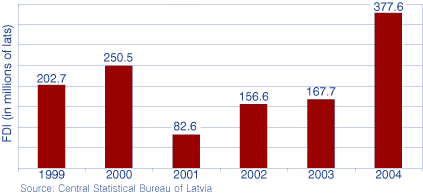
The dominating investors include Sweden, Norway, Finland, Denmark and Germany. They account for more than 50 percent of the total investment, primarily in the fields of finance, real estate, telecommunications, trade and export-orientated manufacturing. About 5 percent of Latvia's FDI comes from the United States (see Figure 2).
Figure 2: FDI in Latvia by Country, 2005
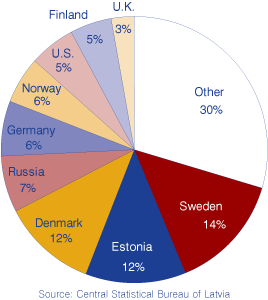
The Latvian Investment and Development Agency cites two basic reasons for FDI growth:
- Substantial differences in operational cost between the east and west coast of the Baltic Sea.
- Investors striving for presence in the fast growing Baltic market and looking at further strategic opportunities in Russia and the Commonwealth of Independent Countries.
As mentioned in the first article in this series, Lithuania, as well as Latvia, could potentially repeat Ireland's success. These Baltic States are almost in the same position as Ireland was in 1980s, in terms of being EU periphery states, having a large trade deficit and very low income per capita). Ireland was called “the poorest of the rich” in a 1988 Economist survey; however, according to World Bank data for 2005, Ireland is now one of the richest EU states with income per capita of $34,280. Latvia and Lithuanian fall at the bottom of that list, with per capita incomes of $5,460 and $5,740, respectively (see Figure 3).
Figure 3: Income per Capita in the European Union, 2005
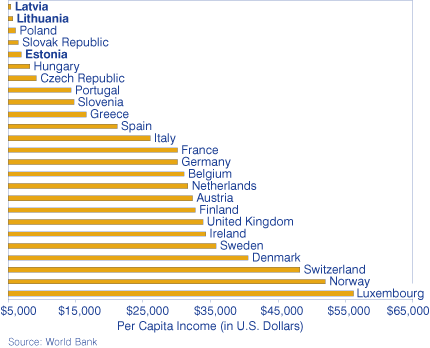
According to some economists, however, this goal may be difficult to achieve due to some substantial differences between Ireland and Latvia. The main driving force for Ireland's FDI growth was U.S. investments, close ties to the United States due to the Irish ancestry of almost 50 million Americans, a common language and Ireland's high quality workforce, especially in information and biotechnology.
Trade
Latvian exports and imports rose dramatically since admission to the EU in 2004 (see Figure 4). Latvian exports increased 33.6 percent in 2005. The increase was seen in all commodity groups, but especially in machinery and mechanical appliances (56.6 percent), prepared foodstuffs and alcoholic and non-alcoholic beverages (50.9 percent), and products of chemicals and allied industries (29.3 percent). The dominant destination for exported goods (76.2 percent) was other EU countries. This figure was up by 31.8 percent in comparison to 2004.
Figure 4: Latvian Imports and Exports, 2000 to 2005
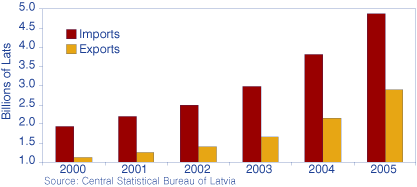
The import value in 2005 rose 27.1 percent compared to the previous year. The fastest growing import groups were mineral products (59.6 percent), transport vehicles (26.5 percent), machinery and mechanical appliances (26 percent), plastic and its articles (29.2 percent) and food products, alcoholic and non-alcoholic beverages (28.7 percent).
Current Latvian export patterns are still concentrated toward “traditional” products (such as wood products or furniture), while exports of products requiring high technological skills remain low. These products constitute a smaller part of total exports due to their low value, but their rate of growth is high. For example, the growth rate of pulp of wood, paper and cardboard was 40.8 percent.
This emphasis on traditional products dates back to the Soviet era, when the majority of investments in the region were focused on the low-value-added industries, including wood, paper and furniture.
While imports from Latvia remained about the same, U.S. exports to Latvia grew by 46 percent between 2004 and 2005. Moreover, exports from Indiana went up 62 percent. Indiana ranked 21st among states in terms of the total amount exported to Latvia, which was almost $1.9 million. The state primarily exported transportation equipment (see Figure 5).
Figure 5: Indiana's Exports to Latvia, 2005
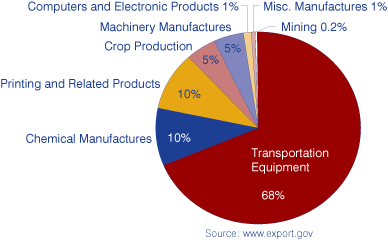
Considering Latvia's economic and political stability, it is reasonable to expect the flow of investment and trade with the United States to continue to grow.
Notes
- “The Luck of the Irish,” Economist, 15 October 2004, available online at www.economist.com/surveys/displayStory.cfm?story_id=3261071
- Morten Hansen, “The Irish Growth Miracle: Can Latvia Replicate?” Baltic Journal of Economics, Summer/Autumn 2005, 3.
- Claus-Friedrich Laaser and Klaus Schrader “Baltic Trade with Europe: Back to the Roots?” Baltic Journal of Economics, Summer/Autumn 2005.
Additional References
- Washington Diplomat, available online at www.washdiplomat.com.
- Ministry of Economy of the Republic of Lithuania, “Review of Economic and Social Situation in the Republic of Lithuania in 2005,” February 2006.
- European Union, available online at www.europa.eu.
- Lithuanian Development Agency, available online at www.orangeprojects.lt/en/
- Ministry of Economy of The Republic of Lithuania, available online at www.ukmin.lt.
- Lithuanian Department of Statistics, available online at www.std.lt.
- World Bank, available online at www.worldbank.org.
- Economies, Bimonthly Review 5, 2004.
Edita Ubartaite, International Development Manager
Indiana Economic Development Corporation
